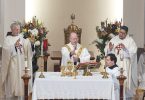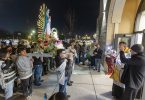by Marc and Julie Anderson
mjanderson@theleaven.org
GARNETT — Like many parish ministries, it started out small — and as a means to help one specific family.
In late 2012, Teresa Nicolas, a member of Holy Angels Parish in Garnett, was diagnosed with cancer for the second time. That’s when two of her friends and fellow parishioners — Sandie Fritz and Linda Huettenmueller — organized a rosary prayer group to pray for Nicolas, her family, and the needs of the millions diagnosed annually with cancer worldwide. The parish’s new pastor, Father Matthew Schiffelbein, wanted to start a rosary prayer group anyway. So the pair obtained his permission to start one on Sunday evenings at the church.
At the time Nicolas received her diagnosis, Huettenmueller said she offered a rosary at least once daily for Nicolas and her family.
“I’d be on my treadmill, doing my exercise, and I’d pray the rosary. I’d pray a decade for Cris (Teresa’s husband), a decade for Teresa. And then, I got a format of praying the rosary for cancer patients from a church in Iola,” said Huettenmueller. “So, that’s what we started out with.”
The format to which Huettenmueller referred was shared by someone from St. John Parish roughly 30 miles away in nearby Iola. That parish had received the format from Our Lady of the Fields in Millersville, Md.
The adapted rosary is known as the Rosary of Life for Those with Cancer. Composed by Bob McWhorter, with input from his daughter Jennifer Marie, the rosary was written in 2010 as Jennifer Marie underwent treatment for melanoma. With encouragement from his wife Rosa, McWhorter began praying the rosary in the specific format he had written at his parish each Tuesday evening.
Each of the four sets of mysteries of the rosary (joyful, sorrowful, glorious and luminous) includes an introductory prayer for healing and a novena prayer to St. Jude, also known as the patron saint of the impossible. Then, the first mystery begins with a short reflection, followed by specific needs or intentions for each of the 10 beads on which are prayed the Hail Mary.
The rosary offered for Teresa Nicolas always ended with a prayer to St. Peregrine, the patron saint of those with cancer, followed by a hymn of gratitude to Mary, the Mother of God.
Although Teresa Nicolas died in late March, her husband Cris wanted the communal rosary to continue. In fact, according to parish secretary Sheila Wilson, when Cris came in to plan Teresa’s funeral, he told Wilson and Father Schiffelbein that the rosary should not stop just because Teresa died. She would always be a part of the rosary — just from a different place now.
So, Fritz and Huettenmueller changed the format slightly and made it more inclusive of other needs. For example, since April, the rosary has been prayed for such intentions and groups as St. Rose School, peace, mothers, those in the military, farmers, fathers and sinners, to name just a few. Although the intentions are different, the format is essentially the same with each decade and each Hail Mary bead being offered for a specific need. For example, the rosary prayed on June 16 was offered for all fathers, both living and deceased, and included prayers for biological fathers as well as fathers in faith, such as priests, bishops and the pope.
At least 20 to 25 regularly gather for the rosary, but sometimes the number reaches 50 or so, including some non-Catholics. Each week, the upcoming rosary’s intention is published in the church’s bulletin or distributed via email. Huettenmueller thinks the regular publication of the intentions helps to encourage parish participation.






